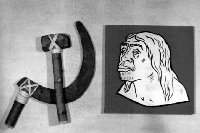At the Last Stop

What kind of harvest will the viewer reap today, watching works of realism dating from the turn of the twenty-first century? Pictures appear with titles like At a New Ukrainian Factory (I wonder if there will ever be any such factories to appear), UNSO Activist Being Interrogated, Managers Writing a Letter to the Tax Inspector, Morning Execution of Racketeers (this one cries out for an allusion to the old anecdote, "Tales and Science Fiction on a Different Bookshelf"), Aftermath of the Battle Between Slobodan Milosevic and NATO Hawks, and The First Lady Meeting Ukrainian Artists (and there really is such an objet d'art).
There is something both somnambulistic and hair-raising about today's realism. Its status is life after death. Like the formidable Cesare guided by Dr. Caligari this specter hangs around exhibit halls, smearing their walls with his phlegm, filling salons, and private collections. His rusty limbs move with a loud screech, echoing from all sides, and we are like guinea pigs, prepared to believe him time and again.
After fooling us for seventy years, realism in this "new society" was then thrown to its knees before the Mammon of capital. In the nineteenth century it went through the motions of caring for the "downtrodden." At the end of the twentieth it turned out to be a cheap errand boy being ordered around by one crime boss after the other at the government level, getting just the treatment such an errand boy deserves. What about the realists? They foam at the mouth at the slightest domestic attempt at postmodernism, however futile, yet when it comes to a moneyed customer they murmur contentedly about there being some good guys, even though from the enemy camp.
I know of several artists (not quite without talent, I should say) who proudly identify themselves as "the President's sculptor." Nothing humiliating there, of course. And yet - try to picture Ilya Repin drawing a picture in which the Russian tsar buys the Zaporizhian Cossacks wholesale for 30,000 gold rubles and orders them to carry out an extremely special assignment. Would the artist refer to himself as being the artist of "His Tsarist Majesty?" This title was perhaps sought by early twentieth century studio photographers to embellish their daguerreotype frames with medals and monograms.
So this is what we have come to: no more Repins, Serovs, Salktykov-Shchedrins, or Chekhovs. Not in our lifetime. Instead, there will be all those cultural lackeys whose main art will be the ringing phrase. Writers will complain about the mother tongue being neglected, rather than about all those speaking the language and made to live in misery (the writers will never mention them because they don't really care about them either way). Painters will no longer make Lenin portraits but portray Jesus - with a curved bleeding smile, meaning that the image will not be that of the Savior but of Judas. Actors will strut onstage like cheap market show buffoons, the way they have always done. Art critics will produce fresh custom-made eulogies, masochistically listing someone else's successful exhibits abroad.
With my hand on my heart, I swear that they have taken us for a ride, not as traitors (for traitor is too honorable a title for them!), but as petty confidence men. But did they do it yesterday? Yes, we had our wave of Ukrainian Socialist Realism (as the British, who nonetheless can take pride that George Orwell did not stoop to it). The most horrible thing is that we did have good art and talent, otherwise we would have ended up with the communist idea capturing the minds of millions. "It is very difficult, almost impossible to picture the nomenklatura running this country with the help of ideology," Yuri Kargamanov writes in Novy Mir [New World], "without our culture showing a sensitivity to that ideology, playing into its hand... One cannot but accuse it of betraying the Russian cultural tradition. Following orders from above, this culture closed the door, barring entrance to the innermost recesses of human existence. It was extremely sensitive, yet it was not spiritual, merely asserting all that falsehood that had become part and parcel of our life."
Persistent attempts are being made to rehabilitate Social Realism. Its exponents insist that painting flowers, benches in park alleys, sweethearts, and dewy dreamy mornings was good (there is a provincial artist named Yefimenko who still paints bouquets, although in Paris. Fifteen years ago he used to embellish Soviet Party congresses. So where is justice? Are the French totally blind?). Right, leave them alone; they are good folks. But this approach may well have disastrous consequences. After returning to power, the realists will once again exchange prizes and laurels with each other, and then will do their best to prevent genuine art from appearing, art without a subject, light and shadow, volume, main idea, etc. In which case I would not pay a cent for all those carriers of alternative art.
There is, however, the revenge of history. Here no one will care about yet another political change. Realism will stay, of course - somewhere by the side of the road, close to the ditch. In museums (with classical expositions), art salons (offering exhibits to embellish one's sitting room with fresh wallpaper designs), institutions of learning (as training aids to help raise another rebellious generation), somewhere down Andriyivsky uzviz (a display intended for provincial devotees). Quantitatively, this trend might outnumber all the others, yet twenty-first century artistic guideline will be traced along different latitudes, the course plotted by masters whose names we obviously do not yet know.
Our realism is to return to communism, to row backwards, to that glorious
Commune where we have already been.
Newspaper output №:
№17, (1999)Section
Culture





